Abstract
Clinching is the manufacturing process of joining two or more metal sheets under high plastic deformation by form and force closure without thermal support and auxiliary parts. Clinch connections are applicable to difficult-to-join hybrid material combinations, such as steel and aluminum. Therefore, this technology is interesting for the application of AISI 304 components, as this material is widely used as a highly formable sheet material. A characteristic feature of AISI 304 is its metastability, i.e., the face-centered cubic (fcc) γ-austenite can transform into a significantly stronger body-centered cubic (bcc) α’-martensite under plastic deformation. This work investigates the effect of heat treatment—a process that involves the formation of an oxidation layer on the sheet surface—on the forming process during joining and the resulting mechanical properties of clinch joints made from AISI 304. For this purpose, different joints made from non-heat treated and heat-treated sheets were examined using classical metallography and advanced SEM techniques, accompanied by further investigations, such as hardness and feritscope measurements. The shear tensile strength was determined, and the fracture behavior of the samples was investigated. Clear influences of heat-treatment-induced surface roughness on the joint geometry and strength were observed.
1. Introduction
AISI 304 is a metastable austenitic stainless steel (MASS) with a high strength and ductility. This combination of properties can be attributed to the reaction of the material to plastic deformation, i.e., deformation-induced martensitic transformation (DIMT) [1]. In the case of DIMT, face-centered cubic γ-austenite is transformed into body-centered cubic α’-martensite. The physical driving force determining this behavior is the stacking fault energy, which depends on the chemical composition of the MASS and the temperature [2]. Low temperatures lead to a reduction in the stacking fault energy, which favors DIMT [3]. The α’-martensite formed under plastic deformation has a higher strength than the initial γ-austenite and induces residual compressive stresses in the material due to volume expansion [4]. During the mechanical processing of AISI 304, attention should be paid to the consequences that DIMT may have on the processing quality and the property distribution in the overall microstructure. On the one hand, DIMT can be deliberately used to adjust the properties of the resulting components locally, as has been shown in the case of forming processes such as, e.g., tube [5] and shear forming [6]. On the other hand, process-related structural damage can be introduced into the material through excessive work hardening. Studies have shown that cracks can be formed during the deep drawing of cups due to high residual stresses [7]. During the mechanical deformation of MASS, attention should be paid to the temperature of the material, because high strain rates—also obtained by means of multiaxial deformation—lead to the adiabatic heating of MASS. This can be beneficial for the material’s formability, while resulting in the suppression of DIMT and its strengthening effect [8]. A comparable outcome was observed when implementing the wire-drawing process with the application of electric current pulses [9]. Hence, α’-martensite induced increases in both mechanical quasi-static and cyclic properties of MASS [10].
However, the underlying phase transformation mechanism strongly depends on the particular forming conditions [11]. Depending on the temperature range and the microstructure present, heat treatment can promote chemical homogenization and the re-transformation of α’-martensite into γ-austenite and reduce the dislocation density. AISI 304 is often applied in the form of rolled sheets. The initial strip casting and subsequent rolling process result in segregation zones over the thick area of the rolled sheet [12]. Since stacking fault energy depends on the chemical composition of the material, the tendency towards DIMT also varies locally in the case of rolled sheets. This effect may, however, be countered through specific heat treatments. For example, AISI 304, loaded in the low-cycle fatigue regime, showed significant differences in the cyclic DIMT behavior when heat-treated prior to cyclic testing compared to the as-received reference state [13]. However, it is not only the chemical composition and probable segregations that have an influence on DIMT. The deformation history of a semi-finished sheet also plays a decisive role. The formation of shear bands is of particular importance for DIMT, since an overlapping of the shear bands serves to create nucleation sites for the α’-martensite transformation. Shear bands are composed of stacking faults, which result from the splitting of perfect dislocations into partial dislocations [14,15]. The initial dislocation state in MASS is therefore of particular importance for DIMT [16]. Depending on the temperature range used for any type of heat treatment, dislocation interactions or even recrystallization processes may also influence the tendency for DIMT. As a result, the application of heat treatment has a significant influence on the mechanical properties of MASS [17].
In summary, the processing of metastable austenitic steel, such as, e.g., AISI 304, requires a solid understanding of DIMT and its most important influencing variables, in particular when used as a base material for modern form- and force-fit-related joining technologies, such as clinching.
Clinching is a joining technology categorized as “Joining by Forming”, according to the German standard 8593-5 [18]. The connection between the overlapping joining parts is realized through a local deformation due to the relative movement of the punch and the die as joining tools [19]. This method can be used for two or more metal sheets, tubes and/or profiles, whereby the punch moves and, thus, the material shifts away from the metal plane, as shown in Figure 1. The subsequent upsetting of the material enables an expansion and a lateral extrusion and, hence, leads to the formation of a permanent joint. Two binding mechanisms exist in a clinching joint, known as form and force closure.
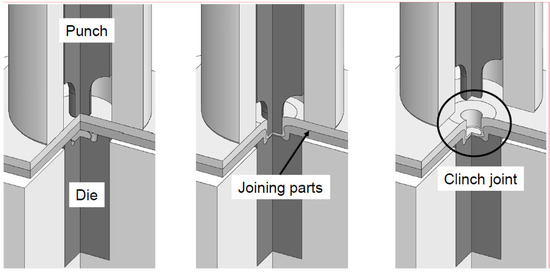
Figure 1.
Schematic representation of the clinching process, adapted from [20].
The quality control of the clinch joints is carried out, firstly, by measuring the bottom thickness, because it this the only measurable geometrical feature by means of non-destructive testing. Secondly, force–displacement curves are recorded during the clinching process, as seen in Figure 2. This force–displacement curve illustrates the mechanical material processing during the clinching process, starting with the placement of the blank holder. Subsequently, the force stroke is triggered, and the components are first elastically deformed (Figure 2, label 1) and then elastically-plastically deformed (Figure 2, label 2) during the further movement of the punch stroke. The two joining partners are penetrated by the punch, and the die-side joining partner reaches the anvil of the die (Figure 2, label 3). Following this process step, the radial material flow is initialized, which generates the undercut between the components. This process step is completed by setting the bottom thickness when the maximum process force is reached (Figure 2, label 4). The return stroke of the punch then takes place (Figure 2, label 5). The blank holder now has the function of a stripper and demolds the clinched joint, removing it from the tools.
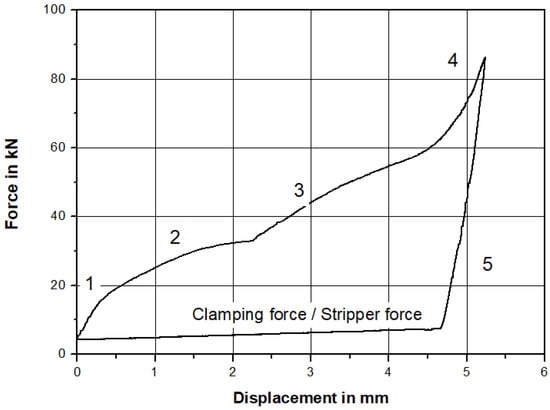
Figure 2.
Characteristic force–displacement curve of the clinching process, where labels 1 to 5 stand for the successive stages of the clinching process: elastic deformation of the components (1), elastic-plastic deformation of the components (2), penetration of the punch (3), reaching the maximum process force (4) and return stroke (5).
The force–displacement curve depends, among other things, very strongly on the surface condition of the joint partners. In this work, the influence of heat treatment in air on the clinching process of an AISI 304 alloy, as well as its effects on the microstructure and the mechanical properties of the clinch joint, are investigated. The heat treatment leads to the effect of the oxidation of the surface, which causes a change in the surface roughness and, thus, the coefficient of friction. This has an influence on the material flow during the clinching process and, thus, on the clinch joint geometry. The question is whether this initially undesirable surface effect has a positive impact on the mechanical properties of the joint or not. Heat treatment at high temperatures leads to grain growth and a reduction in dislocations. Therefore, in the following pages, we will investigate to what extent an increase in the formability of AISI 304 as a result of heat treatment leads to better a clinchability or influences mechanical properties. Finally, we will assess whether the necessary increase in the process force due to the increased friction coefficients of the oxidized surface during clinching outbalances the positive effect of the increased deformability due to the softening of the base metal sheet made from AISI 304, which is caused by the heat treatment.
For this purpose, the microstructures of semi-finished AISI 304 sheets were examined in their as-received and heat-treated conditions through metallographic examinations and advanced scanning electron microscope (SEM) techniques prior to joining. After the clinching process, the samples were examined regarding the formation of the clinch geometry, on the one hand, and the microstructural changes in the highly deformed regions of the joint, including hardness measurements and feritscope measurements. The mechanical properties were investigated by shear tensile tests, and the failure modes were evaluated.
2. Material and Methods
For MASS, it is of great importance to consider the chemical composition of the steel if the role of DIMT is to be included in the investigation. Therefore, all specimens in the present work were prepared from the same batch. The chemical composition of the AISI 304 batch used in this work is shown in Table 1.

Table 1.
Chemical composition of AISI 304.
The material investigated refers to a semi-finished, rolled, 2 mm thick sheet that was first cut into 105 × 45 mm rectangular parts prior to clinching. Half of these were subjected to a heat treatment at 1090 °C for 1 h in air followed by rapid cooling in circulating air (heat-treated: HT). The other half of the rectangular parts were left untreated and, herein, this is referred to the as-received (AR) condition. The short forms HT and AR are used to label the heat treatment conditions used for the clinched samples.
2.1. Characterization of the Initial Base Material in the As-Received and Heat-Treated Conditions
Both conditions were first examined in terms of their microstructure and surface properties. For the investigation of the microstructure, metallographic cross-sections were prepared and electro-chemically polished, thus impeding the formation of preparation-induced α’-martensite. To achieve a surface that was as uniformly polished as possible, the specimens were plunged into the electrolyte A2, from Struers, while being stirred at the same time through an automated process. After this preparation step, the samples were analyzed using electron backscatter diffraction (EBSD) analyses to compare their deformation states based on the so-called grain orientations spread (GOS). The JEOL JIB4610 SEM (JEOL Ltd., Tokyo, Japan), with an Oxford detector, was used to evaluate the GOS using the AZtec software (version 2.1, Oxford Instruments, Abingdon, UK). Based on the GOS analyses and the interpretation of the stored deformation energy within single grains, the deformation states in the heat-treated and as-received conditions were assumed. Subsequent to the EBSD analysis, the samples were subject to a grain boundary etching procedure in order to gain further information about the grain morphology. The etching was carried out through the pickling of hydrochloric acid, nitric acid and a pickling inhibitor (V2A etchant). In addition to determining the grain morphology, this also enables a qualitative assessment of the α’-martensite content. Besides the metallographic analyses of the cross-sections, the initial surfaces in the AR and the HT conditions were examined by means of scanning electron microscopy. Furthermore, electron dispersive spectroscopy (EDS) was performed on the oxide layer. An Oxford detector and AZtec software were used for this purpose. The average roughness Ra and the difference between the maximum peak and the deepest valley Rz were measured so as to quantify the differences between the surfaces using a Surfcom NEX001 (Carl Zeiss AG, Oberkochen, Germany) roughness meter.
2.2. Characterization of the Clinch Process and Joints
After the heat treatment, the sheets were clinched in all possible combinations, resulting in the sample series AR-AR, AR-HT, HT-AR and HT-HT, where the forward position refers to the top sheet (punch-side) and the second position refers to the bottom sheet (die-side). The clinch connections were produced by means of a displacement-controlled process. In order to ensure the comparability of the results, the bottom thickness was set to about 1 mm, and the same toolset was used for all the connections. A fixed round-point die with a diameter of 8 mm and a depth of 1.6 mm, combined with a conical punch with a tip diameter of 4.6 mm, was used. All series were clinched at room temperature without thermal support. Two different specimen geometries were manufactured. Figure 3 shows the geometry of the shear tensile test specimens in (a) and that of the structural investigation specimens in (b). Figure 3c shows the relevant features of the characterization of the clinch joint geometry and how they were measured in a cross-section.
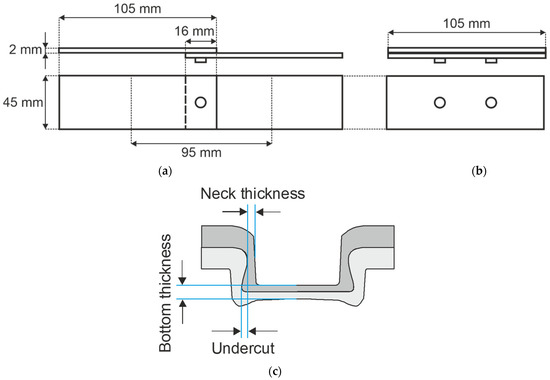
Figure 3.
Specimen geometry for (a) shear tensile testing and (b) structural investigations and (c) schematic of the measurement of relevant features of the clinch joint geometries in a cross-section.
Cross-sections at different punch depths were analyzed to better understand the influence of the surface conditions with and without oxide layers. In particular, the starting point of the undercut formation allows one to draw conclusions about the material flow depending on the surface roughness and the related friction conditions between the sheets to be jointed. Clinch samples with punch depths of one, two, three and four millimeters were prepared in addition to the finished clinch joints. For this purpose, one sample per punch depth was examined. The cross-section results also served as a basis for the interpretation of the characteristics of the force–displacement curves registered during the clinching process. For each clinch depth, the geometry of the connections were investigated by light optical microscopy (LOM). For this purpose, cross-sections were prepared by cold mounting and cutting precisely through the center of the joints, followed by grinding and polishing. In the final stages of the clinching process, the microstructure was investigated and the geometric features, including the bottom thickness, undercut and neck thickness, were determined. For this purpose, we employed the same methods as those used for the microstructure investigation of the base materials in the AR and HT conditions. All light optical microscopic examinations were performed with an Me4F microscope (Leica Microsystems, Wetzlar, Germany).
2.3. Mechanical Properties of the Clinch Joints
Vickers hardness tests were performed on cross-sections of the fully joined clinch joints. For this purpose, measuring points were established on both the die-side and the punch-side sheets. The measuring points were located at identical distances of 0.75 mm for all specimens, being as close as possible to the center of the respective sheet. Since the hardness, in the case of MASS, correlates not only with the degree of deformation, but also with the degree of formed α’-martensite, feritscope FMP30 (Helmut Fischer GmbH, Sindelfingen, Germany) measurements were performed on the bottom of the clinch joints. Therefore, the measuring head of the feritscope was adjusted to the center of the clinch joint of the die-side sheet.
The tensile test specimens were tested through quasi-static shear tests (5 mm/min), according to ISO 14273 [21], using a universal testing machine Inspekt Table 50 (Hegewald & Peschke Meß- und Prüftechnik GmbH, Nossen, Germany). The failed specimens were assessed for their failure behavior by visual observation of the fracture surfaces.
3. Results
3.1. Characterization of the Initial Conditions
According to the procedure described in the previous section, EBSD measurements were first carried out on the electro-chemically polished samples. The grain orientation spread (GOS) in both initial conditions, AR and HT, are depicted in Figure 4 It can be observed that the spread is less than 0.1° in both conditions. As was shown for an Mg-Zn-Zr alloy in [22], investigating the effect of dynamic recrystallization on grain distortion, GOS can be applied to analyze the deformation states represented in a microstructure. Hence, the very low GOS value observable in both conditions of the base plates suggests that the initial microstructure can be assumed to be undeformed. The heat treatment, however, led to a pronounced recrystallization of the sheets, as shown by the pronounced variation in the grain size between both conditions, comparing Figure 4a with Figure 4b. In addition, the phase contents of the bcc and fcc were measured, and both conditions were fully fcc, i.e., austenitic.
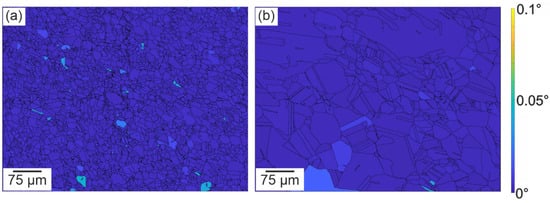
Figure 4.
Grain orientation spread determined by EBSD measurements in the conditions of (a) AR and (b) HT.
Figure 5 shows the results of the LOM for the base materials in the AR condition (a) and HT condition (b). It can be seen that the heat treatment, at 1090 °C for 1 h, resulted in significant grain and twin coarsening. Apart from this, the linearly oriented precipitates, as depicted in Figure 5a, seem to somewhat follow the rolling direction, whereas the precipitates in the HT condition (Figure 5b) are less frequent and do not show any preferentially oriented lineup.
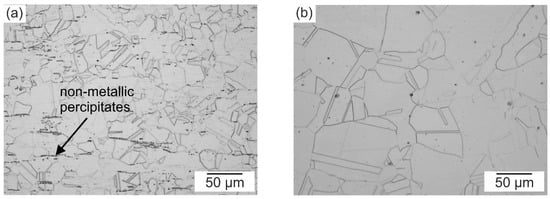
Figure 5.
Light optical microscopy of the microstructure in the conditions of (a) AR and (b) HT. The black dots are precipitates.
The heat treatment did not only have a significant effect on the microstructure of the rolled sheets made from AISI 304. The surface was also significantly affected, as can be seen in the SEM images shown in Figure 6. Figure 6a shows the AR condition and Figure 6b shows the HT condition. Figure 6a depicts the rolled surface, which is characterized by a smooth surface, where the grain morphology is visible. In contrast, the heat treatment resulted in strong oxidation on the surface, which was porous and cratered, as can be seen in Figure 6b.
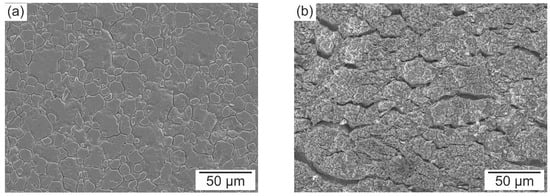
Figure 6.
Surfaces observed by means of SEM in the conditions of (a) AR and (b) HT.
The results of the EDS measurements of the oxide layer are listed in Table 2. Mainly, two different oxides were found, including Cr-rich and Fe-rich oxides.

Table 2.
EDS analyses of the oxide layer in At-%.
The difference is also clearly reflected in the measured roughness values. Measurements were taken longitudinally and transversely to the sheets’ rolling direction, and no significant differences were observed in both directions. The averaged results of the roughness measurement for the two conditions are shown in Table 3, where Ra and Rz were significantly higher in the heat-treated condition due to the formation of a rough oxide layer on the surface. It should be emphasized that these parameters only serve to illustrate the relative differences in roughness and do not correspond to the standard specifications.

Table 3.
Surface characteristics in the AR and HT states determined by means of a roughness meter.
3.2. Characterization of the Clinch Process and Joints
Once the characterization of the original microstructures and surface conditions of the sheets to be joined have been carried out, the focus can be directed to the joining process itself. The clinch process examinations and the joint properties are presented in the following pages. A comparison of the process graphs in Figure 7 shows that the different combinations of the parts destined to be joined had only a slight effect on the force–displacement curve during the joining process. The slightly higher process force measured during the clinching process step for the HT specimens implies that there was a higher friction force between the components and the tools, and between the joining partners themselves, which was effective.
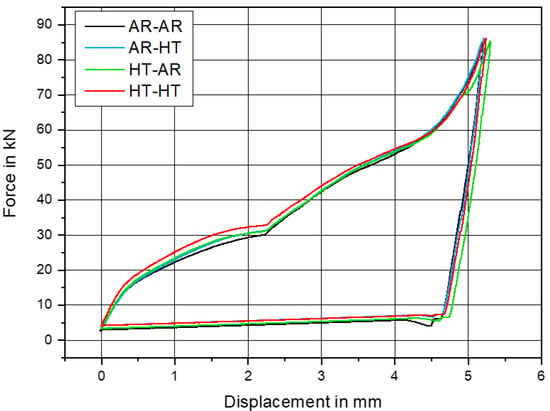
Figure 7.
Comparison of the force–displacement curves under all investigated conditions of the clinching process.
Figure 8a–e shows the cross-sections at different punch depths during the clinching process of the AR-AR series. It can be seen that the undercut is formed as late as during the stage shown in Figure 8d, representing a punch depth of 4 mm, and that, at the end of the joining process, the bottom thickness is relatively evenly distributed in one sheet and across both sheets (compared to Figure 9e).
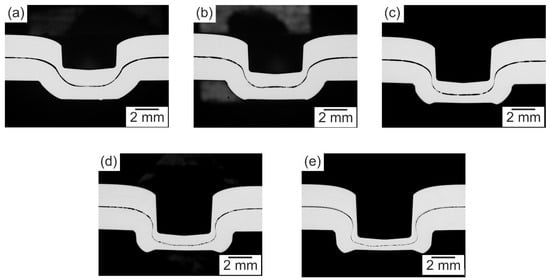
Figure 8.
Cross-sections of the clinch samples in the condition of AR-AR with a punch depth of (a) 1 mm, (b) 2 mm, (c) 3 mm, (d) 4 mm and (e) 5 mm.
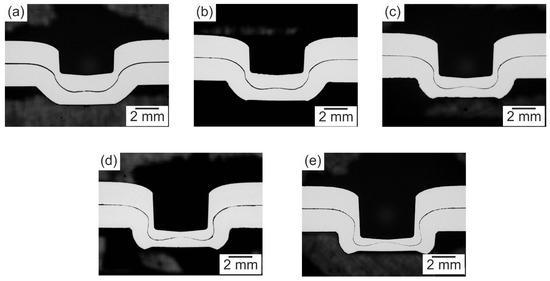
Figure 9.
Cross-sections of the clinch samples in the condition of HT-HT with a punch depth of (a) 1 mm, (b) 2 mm, (c) 3 mm, (d) 4 mm and (e) 5 mm.
In contrast to the AR-AR specimen, it can be seen, for the HT-HT condition in Figure 9a–e, that a slight undercut is already visible in Figure 9c at a punch depth of 3 mm. Immediately after the first step of the work, an uneven distribution of the bottom thickness between the two sheets becomes apparent. This effect increases with increasing punch depth. At the end of the joining process, the upper sheet is very strongly deformed in the middle of the bottom, so that the established bottom thickness of 1 mm is predominantly observed in the lower sheet. Jónás and Tisza showed that the friction coefficient effective between the sheets to be joined has a significant influence on the clinch joint geometry and the process force [23]. The friction between the two sheets and between the sheets and the tools leads to a change in the material flow. Consequently, the bottom thickness is dissimilar, and the parameters of the neck thickness and undercut are changed, while the bottom thicknesses remain almost equal.
Representative of the mixed joints of an AR and HT sheet, the final state (i.e., where the clinching process has been executed to the full depth, and the punch has been released again) of the AR-HT clinch joint is shown in Figure 10. It can be seen that there is an uneven distribution of the sheet thicknesses in the center of the bottom part due to the roughness of the HT sheet; however, it is less distinct than in the HT-HT condition.
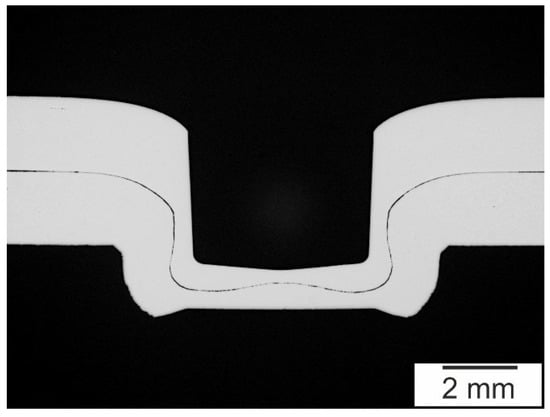
Figure 10.
Cross-section of the clinch samples in the condition of AR-HT with a punch depth of 5 mm.
The images of the final clinch geometry of all the joint combinations were used to measure the neck thickness, undercut and bottom thickness. For the neck thickness and undercut, the left and right sides of the joint were measured using the observed cross-section. The bottom thickness was determined by measuring the thickness of the two sheets at the center of the clinch point. Table 4 presents the obtained results of the measurements. These values also show a clear difference between the AR-AR state and the rest of the series. The neck thickness, as well as the bottom thickness of the AR-AR specimen, were significantly lower than those observed in the other conditions. The average undercut was the largest; however, it did not turn out to be much larger than that of the HT-HT. For the remaining sample series, no clear trend could be identified from the measured values.

Table 4.
Evaluation of the geometric features measured of the final clinch geometry in the cross-sections.
After the measurements of the clinch joint geometry, the specimens were etched for further microstructural analyses. Figure 11 shows images of cross-sections made from a clinch joint of the AR-AR combination.
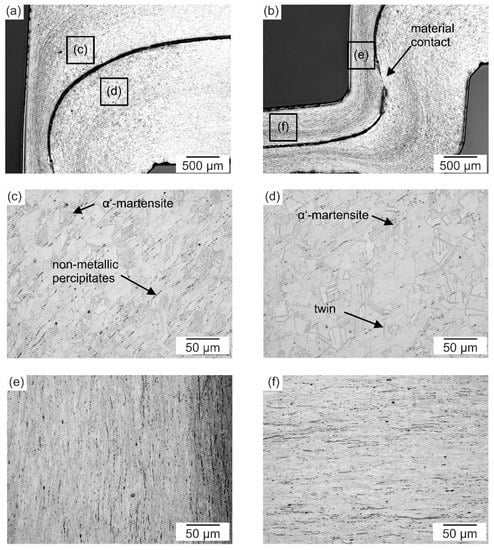
Figure 11.
Microstructure of the AR-AR condition observed on etched cross-sections: (a) overview image of the upper neck area, (b) overview image of the lower neck area and bottom, (c) microstructure detail image of the upper neck area of the punch-side sheet, (d) microstructure detail image of the upper neck area of the die-side sheet, (e) microstructure detail image of the neck at the location of largest deformation, (f) microstructure detail image of the bottom at the location of largest deformation.
In Figure 11b, a partial material contact can be seen. This is plausible, according to a numerical simulation used for an HCT590X clinched joint by Steinfelder et al. [24], which identified the region situated immediately above the undercut as the location with the highest surface pressure within the clinching point. Comparing this with Figure 11c,d, it can be seen that the volume fraction of the deformation-induced α’-martensite forms—which can be seen in the fine, structured, inner-grain areas—increases with the increasing degree of deformation. Individual grains are hardly recognizable at these high degrees of deformation, as shown in Figure 11e,f, which is reflected in the reduction in the sheet thickness in the neck from an initial thickness of 2 mm to less than half a millimeter. The formation of deformation-induced α’-martensite can be estimated only from darker etched areas in the images.
In the case of the HT condition, the heat treatment resulted in significant grain coarsening. This can be seen in the images of the clinched HT-HT sample in Figure 12. The α’-martensite induced by the deformation is also clearly visible in the overview images of the transition from the base material to the neck in Figure 12a and the transition from the neck to the bottom in Figure 12b. However, in the detailed images of the neck in Figure 12c and the bottom in Figure 12d, a similar picture emerges as that observed before for the AR-AR specimen. Individual grains and α’-martensites are difficult to identify due to the very high degrees of deformation. Therefore, it was not possible to determine the α’-martensite content based on these images.
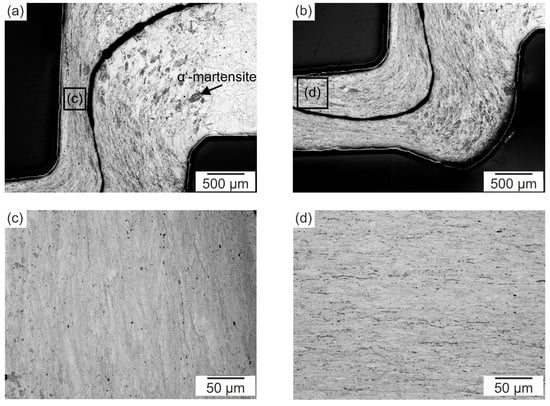
Figure 12.
Microstructure of the HT-HT condition observed in the etched cross-sections: (a) overview image of the upper neck area, (b) overview image of the lower neck area and bottom, (c) microstructure detail image of the neck at the location of the largest deformation, (d) microstructure detail image of the bottom at the location of the largest deformation.
Representative of the mixed joints, the overview images of the AR-HT joint are shown in Figure 13. Figure 13a shows the transition from the base material to the neck, and Figure 13b shows the transition from the neck to the bottom. It can be seen that the punch-side AR sheet is similar to the punch-side sheet in the AR-AR, and the die-side HT sheet is similar to the die-side sheet in the HT-HT joint. Furthermore, it can be seen from Figure 13b that the high degrees of deformation in the bottom caused both sheets to be deformed to such an extent that the differences in the initial condition can no longer be clearly distinguished. Due to the existing oxide layer, material contact could not be observed for joints with at least one heat-treated sheet, preventing direct contact between the sheets.
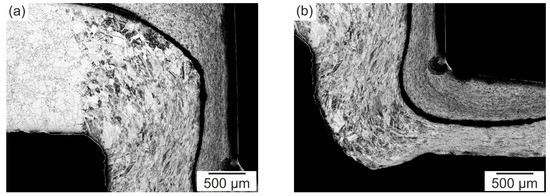
Figure 13.
Microstructure of the AR-HT condition observed in the etched cross-sections: (a) overview image of the upper neck area, (b) overview image of the lower neck area and bottom.
3.3. Mechanical Properties of the Clinch Joints
For the further characterization of the clinched joints, hardness measurements were performed on the cross-sections of the fully clinched joints. The results are shown in Figure 14 where, in the diagrams, the hardness is plotted against the location of the measured values, as illustrated by a clinch point cross-section. Figure 14a shows the measured values of the plate on the punch-side and (b) shows the measured values of the plate on the die-side.
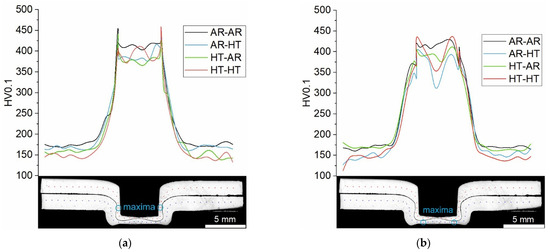
Figure 14.
Hardness measurements of all the tested conditions of the (a) punch-side sheet and the (b) die-side sheet. Maxima are highlighted.
The degree of deformation, i.e., the plastic strain, correlates with the change in the material thickness [25]. It can be seen that the highest hardness values were measured in the neck area, which are also shown as numerical values in Table 5. This was expected, since the highest degrees of deformation were realized in this particular region, resulting in the highest strain hardening and, thus, potentially the largest α’-martensite volume fractions. It is also noticeable that the AR-AR condition shows only very slight deviations in the hardness in the bottom area of the joint. This is because the bottom thickness was realized evenly across both sheets, as shown in Figure 8e. The other joints tended to have an uneven distribution of the bottom thickness due to their higher roughness. Therefore, higher standard deviations were determined.

Table 5.
Overview of the selected properties obtained from the hardness measurements of all investigated conditions.
The fact that the clinch joints, especially AR-AR, compared to the rest of the series, show significant differences in the local degree of deformation made it difficult to use the hardness as an indication of α’-martensite formation. The very high degrees of deformation and associated distortion of the metal lattice in the neck and bottom regions also made it very difficult to determine the α’-martensite volume fractions by optical measurements or EBSD. In order to perform a qualitative assessment of the α’-martensite formation, measurements were carried out using a feritscope on the die-side sheets of the clinch points of the manufactured tensile test specimens. Since a clinch joint has a very complex joining geometry, and it is not possible to determine the exact volume measured by the feritscope, the specification of the measured values was omitted in favor of a qualitative assessment. This is shown in Figure 15, where the measured intensities of the magnetic signal for the four series are displayed. As mentioned, the measurements were taken from the die-side sheets, i.e., on the AR sheets for AR-AR and HT-AR and on the HT sheets for AR-HT and HT-HT.
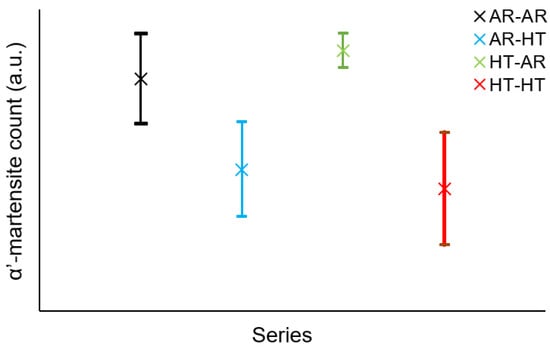
Figure 15.
Qualitative presentation of the results of feritscope measurements on the die-side sheets in all conditions.
The measurements taken by means of the feritscope give a clearer picture than that yielded by the hardness measurements. It can be seen that the AR sheets of the AR-AR and HT-AR series had higher α’-martensite volume fractions than the HT sheets of the AR-HT and HT-HT series. Nevertheless, this difference is not very large, since the scatter bands overlap slightly. This correlation is plausible, since both conditions involved very low initial deformation states, as shown by the EBSD measurements in Figure 4. Therefore, the decisive factor for DIMT is the grain size, whereby bigger grains lead to a lower DIMT [26].
Quasi-static shear tests were performed following the microstructure analyses of the four series. Five samples per series were tested, and the results are shown in Figure 16.
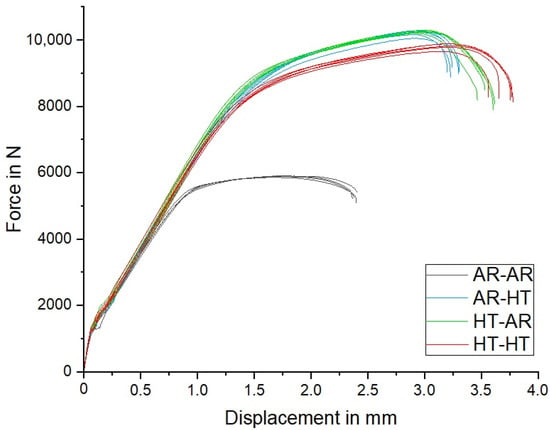
Figure 16.
Force–displacement curves of the shear tensile tests in all conditions.
The first point that stands out is that the AR-AR series lags far behind the rest of the series in terms of both the maximum force and maximum displacement achieved. The numerical values are listed in Table 6. The mixed joints, AR-HT and HT-AR, achieved the highest tensile forces, with HT-AR additionally exhibiting a displacement increased by approx. 10%. In contrast, the maximum tensile force achieved by HT-HT was approx. 5% lower, with roughly the same elongation as that of HT-AR.

Table 6.
Overview of the properties obtained from the shear tensile tests of all the investigated conditions.
To assess the findings of the quasi-static shear tests, the fracture surfaces of the specimens were examined, as shown in Figure 17. In the case of the AR-AR specimens (see Figure 17a), the sheet on the punch-side cracked in the neck area before it was pulled out from the clinch joint. For all other series, in Figure 17b–d, the sheet metal on the punch-side remained in the joint until it was completely torn off. In this process, the non-joined sheet metal on the die-side below the clinching point was also deformed.
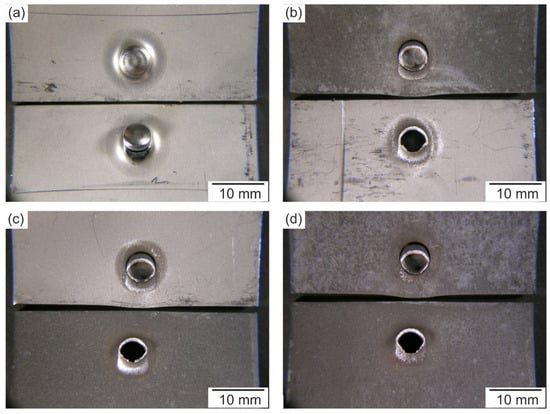
Figure 17.
Exemplary images of the failed specimens of the shear tensile test in the conditions of (a) AR-AR, (b) AR-HT, (c) HT-AR and (d) HT-HT.
4. Discussion
This section discusses the heat treatment’s influence on the clinching process itself and the resulting mechanical properties of the four different joining arrangements. A decisive factor in the investigations was the fact that all the samples examined were made from one batch; thus, the chemical composition of all the specimens was the same. This is crucial for MASS, since different chemical compositions lead to different α’-martensite transformation behaviors. It was thus possible to ensure that all differences in the microstructure and mechanical properties originated from processing through the heat treatment and clinching. Heat treatment significantly changed the properties of the sheets. Grain coarsening occurred, and the surface oxidized considerably, resulting in an increase in the roughness, as shown in Figure 5 and Figure 6. Furthermore, it should be noted that these oxides typically have a much higher hardness and brittleness than the base material.
In order to answer the central questions posed in this work, i.e., whether a heat treatment improves the mechanical properties of the clinch joint by affecting the joining process, the effects of the individual changes must be considered and compared. The force–displacement curves of the clinching process (Figure 7) only show slight differences. Therefore, it can be concluded that the heat treatment and the resulting surface condition have only slight influences on the joining process itself. In contrast, there are significant differences in the properties of the joint. Zeuner et al. demonstrated the influence of the heat treatment of ASI304 on the mechanical properties of the base material [27]. It can be summarized that the tensile strength and the yield strength decrease, while the total displacement increases due to a similar heat treatment. Bielak et al. showed that the mechanical properties of the base material influence the resulting clinch geometry [28]. Additionally, Kalich and Füssel also showed that the surface condition and the resulting friction affects the joint geometry and the binding mechanisms [29]. In this work, the influences of the mechanical properties of the base material and the surface roughness cannot be considered separately, since the heat treatment carried out in air always led to the formation of an oxide layer on the surface and, as a consequence, a significant change in the roughness of the material investigated. Meanwhile, depending on the deformation conditions, α’-martensite was formed in AISI 304. Due to the different friction between the joining partners themselves and between the sheets and the tools, the material flow during clinching was affected, resulting in an unevenly distributed bottom thickness (see Table 4). In the case of clinch joints containing at least one heat-treated sheet, this effect was confirmed, since the deformation in the bottom area was inhomogeneous. This is also reflected in the hardness measurements shown in Figure 14. In contrast, it was observed that the hardness profile in the bottom of the AR-AR sample was more uniform than those of the other series, where noticeable deviations occurred. This alone indicates a complex interaction. The EBSD investigations showed that the two initial states (AR and HT) differed only in grain size. In both states, the grains did not show any sign of initially stored deformation, as the GOS value was rather low in both conditions. Therefore, the DIMT can be related to the grain size. This can also be seen in the feritscope measurements, which will be discussed later. It appears that the grain size effect and the associated improved formability compensate for the force required for clinching by the increase in the amount of friction. As a result, there are no significant differences in the process performance.
Although the production of the specimens was carried out by comparable means, different joint geometries were obtained. Abe et al. [30] showed that, in addition to the material properties, the geometric features, such as the undercut and neck thickness, influence the mechanical properties. Therefore, material properties may have an influence, but the effects of the geometry of the clinch joints tend to predominate. In addition, Ewenz et al. [31] showed that the material flow affects the form and force closure as well. Consequently, an unambiguous assignment of the joint mechanical properties to the material condition, on the one hand, or to the geometric features of the clinch joint, on the other, is a true challenge. However, a comparison can be made using the same process parameters, and a preferred sheet combination can be derived from this. In light of this, the mechanical properties have to be included in the discussion.
Comparing the results of the shear tensile tests in Figure 16, the AR-AR specimens showed, by far, the lowest maximum tensile forces and displacement. By taking into account the fracture surfaces in Figure 17, the reason for this behavior becomes apparent. Figure 17a shows a crack in the AR-AR specimen in the neck area and that the punch-side sheet was pulled out. For all the other series, it was observed that the material of the punch-side sheet failed without being pulled out from the clinch connection. When considering the clinch geometries achieved and their parameters, as shown in Table 4, it was found that the AR-AR condition tends to form the largest undercut, which should lead to a high joint strength. In addition, the neck thickness tended to be the lowest, which should favor a neck fracture instead of a pull out. As a consequence, it can be assumed that clinch geometry does not play the decisive role regarding the pronounced differences in the static strength of the four conditions analyzed. When at least one heat-treated sheet is used to realize the clinching joint, the joint gains significant strength. The reason for this is the significantly rougher surfaces of the heat-treated sheets. This provides friction between the two sheets, which is sufficiently large enough to prevent the material from be pulled out of the joint. Instead, the material itself fails. Here, it did not seem to have a major influence regardless of whether both or only one of the sheets was heat treated.
The differences in the static strength of the conditions with at least one heat-treated sheet are rather low. HT-HT tended to show the largest deformations but achieved lower maximum forces in the tensile shear test than the mixed joints. One reason for this may be the decrease in the Hall–Petch effect and the lower α’-martensite formation capacity due to grain coarsening [26]. The feritscope measurements also confirmed this effect, as shown in Figure 15. However, the gap geometry, the force closure component and the fluctuations in the process could have also affected this behavior. A separation of these causes is not possible due to their high complexity. It can be qualitatively stated that higher α’-martensite contents were formed in the AR sheets. What is remarkable about the tensile shear deformation behavior of the mixed joints is that they show almost identical behaviors until the maximum force is reached. After that, the force–deformation curve of the AR-HT state drops rapidly, and fracture occurs. In the case of the HT-AR state, on the other hand, the force–displacement curve does not drop off immediately, but first changes to a linear behavior before the final failure occurs. Such a linear force–deformation correlation indicates α’-martensite formation in the MASS [32]. As previously stated, the last step before the final failure of the clinch connections was the failure of the cup of the punch-side sheet. Thus, for the AR-HT condition, this was an AR sheet, whereas for the HT-AR condition, it was an HT sheet. Accordingly, it can be concluded that, as a result of the high degrees of deformation produced by the clinching process and the higher tendency of the non-heat-treated MASS towards α’-martensite formation, the maximum formability of the AR material was mostly reached. Therefore, the AR sheet could not support any further deformation after reaching the maximum force, and rapid failure occurred. However, in the case of the HT material, deformability was still apparent, which led to further α’-martensite formation and thus raised the overall deformability of the clinched joint in the HT-HT condition.
5. Conclusions
In this work, the influence of heat treatment on clinching was investigated. Therefore, four different clinch joint series were produced with the same toolset. The research showed that heat treatment can significantly improve the mechanical properties of an AISI 304 clinch joint. The underlying mechanisms were discussed, and process–structure–property correlations were established. The main findings can be summarized as follows:
- -
- The heat treatment resulted in differences in the microstructure and surface condition. The grain size, as well as the roughness, increased significantly.
- -
- Although, in the case of the heat-treated sheets, the increased grain size resulted in inhibited DIMT behavior, and the higher surface roughness led to different coefficients of the friction, the differences in the clinch joint fabrication were rather small compared to those observed in the non-heat-treated specimens.
- -
- The HT-AR condition achieved the highest maximum shear tensile forces and displacements. The reason for this is the favorable combination of an increase in the friction coefficients, which does not adversely affect the manufacturing but does counteract the unbuttoning of the connection, and the higher formability of the punch-side sheet in the heat-treated condition.
- -
- DIMT is a complex mechanism influencing AISI 304 clinch joints, as it locally affects the manufacturing process, as well as the mechanical properties, and can lead to great differences in α’-martensite formation depending on the chemical composition of the AISI 304, the manufacturing parameters and the type of loading.
Author Contributions
Conceptualization, A.T.Z. and L.E.; methodology, A.T.Z., J.K. and L.E.; validation, A.T.Z. and L.E.; formal analysis, A.T.Z., L.E. and M.Z.; investigation, A.T.Z., L.E., J.K. and S.S.; resources, A.T.Z., L.E. and J.K.; data curation, A.T.Z. and L.E.; writing—original draft preparation, A.T.Z., L.E. and J.K.; writing—review & editing, S.S. and M.Z.; visualization, A.T.Z., J.K. and L.E.; supervision, U.F. and M.Z.; project administration, U.F. and M.Z.; funding acquisition, U.F. and M.Z. All authors have read and agreed to the published version of the manuscript.
Funding
Funded by Deutsche Forschungsgemeinschaft (DFG, German Research Foundation): TRR 285 (project ID 418,701,707) and ZI 1006/15-1 (project ID 413507401).
Institutional Review Board Statement
Not applicable.
Informed Consent Statement
Not applicable.
Data Availability Statement
Not applicable.
Conflicts of Interest
The authors declare no conflict of interest.
References
- Abrassart, F. Stress-induced γ → α martensitic transformation in two carbon stainless steels. Application to trip steels. Met. Mater. Trans. A 1973, 4, 2205–2216. [Google Scholar] [CrossRef]
- Rémy, L.; Pineau, A.; Thomas, B. Temperature dependence of stacking fault energy in close-packed metals and alloys. Mater. Sci. Eng. 1978, 36, 47–63. [Google Scholar] [CrossRef]
- Remy, L. Temperature variation of the intrinsic stacking fault energy of a high manganese austenitic steel. Acta Met. 1977, 25, 173–179. [Google Scholar] [CrossRef]
- Pineau, A.G.; Pelloux, R.M. Influence of strain-induced martensitic transformations on fatigue crack growth rates in stainless steels. Met. Mater. Trans. A 1974, 5, 1103–1112. [Google Scholar] [CrossRef]
- Dally, T.; Grigorescu, A.; Müller-Bollenhagen, C.; Zimmermann, M.; Christ, H.-J.; Weinberg, K. Using Martensite Formation during Tube-Forming to Optimize Fatigue Strength. Steel Res. Int. 2014, 85, 1355–1363. [Google Scholar] [CrossRef]
- Guillot, M.; McCormack, T.; Tuffs, M.; Rosochowski, A.; Halliday, S.; Blackwell, P. Shear forming of 304L stainless steel–microstructural aspects. Procedia Eng. 2017, 207, 1719–1724. [Google Scholar] [CrossRef][Green Version]
- Yuying, Y.; Chunfeng, L.; Hongzhi, X. A study of longitudinal cracking and the forming technology for deep-drawn austenitic stainless-steel cups. J. Mater. Process. Technol. 1992, 30, 167–172. [Google Scholar] [CrossRef]
- Lindgren, M.; Bexell, U.; Wikström, L. Roll forming of partially heated cold rolled stainless steel. J. Mater. Process. Technol. 2009, 209, 3117–3124. [Google Scholar] [CrossRef][Green Version]
- Tang, G.; Zhang, J.; Yan, Y.; Zhou, H.; Fang, W. The engineering application of the electroplastic effect in the cold-drawing of stainless steel wire. J. Mater. Process. Technol. 2003, 137, 96–99. [Google Scholar] [CrossRef]
- Müller-Bollenhagen, C.; Zimmermann, M.; Christ, H.-J. Very high cycle fatigue behaviour of austenitic stainless steel and the effect of strain-induced martensite. Int. J. Fatigue 2010, 32, 936–942. [Google Scholar] [CrossRef]
- Tourki, Z.; Bargui, H.; Sidhom, H. The kinetic of induced martensitic formation and its effect on forming limit curves in the AISI 304 stainless steel. J. Mater. Process. Technol. 2005, 166, 330–336. [Google Scholar] [CrossRef]
- Pham, C.H.; Thuillier, S.; Manach, P.-Y. Prediction of flow stress and surface roughness of stainless steel sheets considering an inhomogeneous microstructure. Mater. Sci. Eng. A 2016, 678, 377–388. [Google Scholar] [CrossRef]
- Man, J.; Smaga, M.; Kuběna, I.; Eifler, D.; Polák, J. Effect of metallurgical variables on the austenite stability in fatigued AISI 304 type steels. Eng. Fract. Mech. 2017, 185, 139–159. [Google Scholar] [CrossRef]
- Olson, G.B.; Cohen, M. A general mechanism of martensitic nucleation: Part I. General concepts and the FCC → HCP transformation. Met. Mater. Trans. A 1976, 7, 1897–1904. [Google Scholar] [CrossRef]
- Olson, G.B.; Cohen, M. A general mechanism of martensitic nucleation: Part II. FCC → BCC and other martensitic transformations. Met. Mater. Trans. A 1976, 7, 1905–1914. [Google Scholar] [CrossRef]
- Milad, M.; Zreiba, N.; Elhalouani, F.; Baradai, C. The effect of cold work on structure and properties of AISI 304 stainless steel. J. Mater. Process. Technol. 2008, 203, 80–85. [Google Scholar] [CrossRef]
- Zheng, C.; Liu, C.; Ren, M.; Jiang, H.; Li, L. Microstructure and mechanical behavior of an AISI 304 austenitic stainless steel prepared by cold- or cryogenic-rolling and annealing. Mater. Sci. Eng. A 2018, 724, 260–268. [Google Scholar] [CrossRef]
- DIN 8593-5:2003-09; Fertigungsverfahren Fügen_-Teil_5: Fügen durch Umformen; Einordnung, Unterteilung, Begriffe. Beuth Verlag GmbH: Berlin, Germany.
- Mori, K.-I.; Abe, Y. A review on mechanical joining of aluminium and high strength steel sheets by plastic deformation. Int. J. Light. Mater. Manuf. 2018, 1, 1–11. [Google Scholar] [CrossRef]
- Reich, M.; Osten, J.; Kozlov, N.; Kessler, O.; Kalich, J. Thermo-Mechanical Simulation of Laser Beam Assisted Clinching for High-Strength Steel. In Thermal Process Modeling, Proceedings from the 5th International Conference on Thermal Process Modeling and Computer Simulation, Gaylord Palms Resort & Convention Center, Orlando, FL, USA, 16–18 June 2014; Ferguson, B.L., Ed.; ASM International: Materials Park, OH, USA, 2014; pp. 39–45. ISBN 9781627080682. [Google Scholar]
- DIN EN ISO 14273:2016-11; Widerstandsschweißen_-Zerstörende Prüfung von Schweißverbindungen_-Probenmaße und Verfahren für die Scherzugprüfung an Widerstandspunkt-, Rollennaht- und Buckelschweißungen mit geprägten Buckeln (ISO_14273:2016); Deutsche Fassung EN_ISO_14273:2016. Beuth Verlag GmbH: Berlin, Germany.
- Hadadzadeh, A.; Mokdad, F.; Wells, M.A.; Chen, D.L. A new grain orientation spread approach to analyze the dynamic recrystallization behavior of a cast-homogenized Mg-Zn-Zr alloy using electron backscattered diffraction. Mater. Sci. Eng. A 2018, 709, 285–289. [Google Scholar] [CrossRef]
- Jónás, S.; Tisza, M. Effect of the Friction Coefficient on Clinch Joints. Int. J. Eng. Manag. Sci. 2020, 5, 86–90. [Google Scholar] [CrossRef]
- Steinfelder, C.; Kalich, J.; Brosius, A.; Füssel, U. Numerical and experimental investigation of the transmission moment of clinching points. IOP Conf. Ser. Mater. Sci. Eng. 2021, 1157, 012003. [Google Scholar] [CrossRef]
- Bielak, C.R.; Böhnke, M.; Bobbert, M.; Meschut, G. Further development of a numerical method for analyzing the load capacity of clinched joints in versatile process chains. ESAFORM 2021, 24. [Google Scholar] [CrossRef]
- NaghiZadeh, M.; Mirzadeh, H. Effects of Grain Size on Mechanical Properties and Work-Hardening Behavior of AISI 304 Austenitic Stainless Steel. Steel Res. Int. 2019, 90, 1900153. [Google Scholar] [CrossRef]
- Zeuner, A.T.; Kühne, R.; Standke, C.; Köberlin, D.; Wanski, T.; Schettler, S.; Füssel, U.; Zimmermann, M. Fatigue Behavior of Laser-Cut Sheet Metal Parts with Brazed-On Elements. Metals 2021, 11, 2063. [Google Scholar] [CrossRef]
- Bielak, C.; Böhnke, M.; Beck, R.; Bobbert, M.; Meschut, G. Numerical analysis of the robustness of clinching process considering the pre-forming of the parts. J. Adv. Join. Process. 2021, 3, 100038. [Google Scholar] [CrossRef]
- Kalich, J.; Füssel, U. Design of clinched joints on the basis of binding mechanisms. Prod. Eng. Res. Devel. 2022, 16, 213–222. [Google Scholar] [CrossRef]
- Abe, Y.; Kato, T.; Mori, K.-I.; Nishino, S. Mechanical clinching of ultra-high strength steel sheets and strength of joints. J. Mater. Process. Technol. 2014, 214, 2112–2118. [Google Scholar] [CrossRef]
- Ewenz, L.; Kalich, J.; Zimmermann, M.; Füssel, U. Effect of Different Tool Geometries on the Mechanical Properties of Al-Al Clinch Joints. Key Eng. Mater. 2021, 883, 65–72. [Google Scholar] [CrossRef]
- Barat, K.; Bar, H.N.; Mandal, D.; Roy, H.; Sivaprasad, S.; Tarafder, S. Low temperature tensile deformation and acoustic emission signal characteristics of AISI 304LN stainless steel. Mater. Sci. Eng. A 2014, 597, 37–45. [Google Scholar] [CrossRef]
Publisher’s Note: MDPI stays neutral with regard to jurisdictional claims in published maps and institutional affiliations. |
© 2022 by the authors. Licensee MDPI, Basel, Switzerland. This article is an open access article distributed under the terms and conditions of the Creative Commons Attribution (CC BY) license (https://creativecommons.org/licenses/by/4.0/).